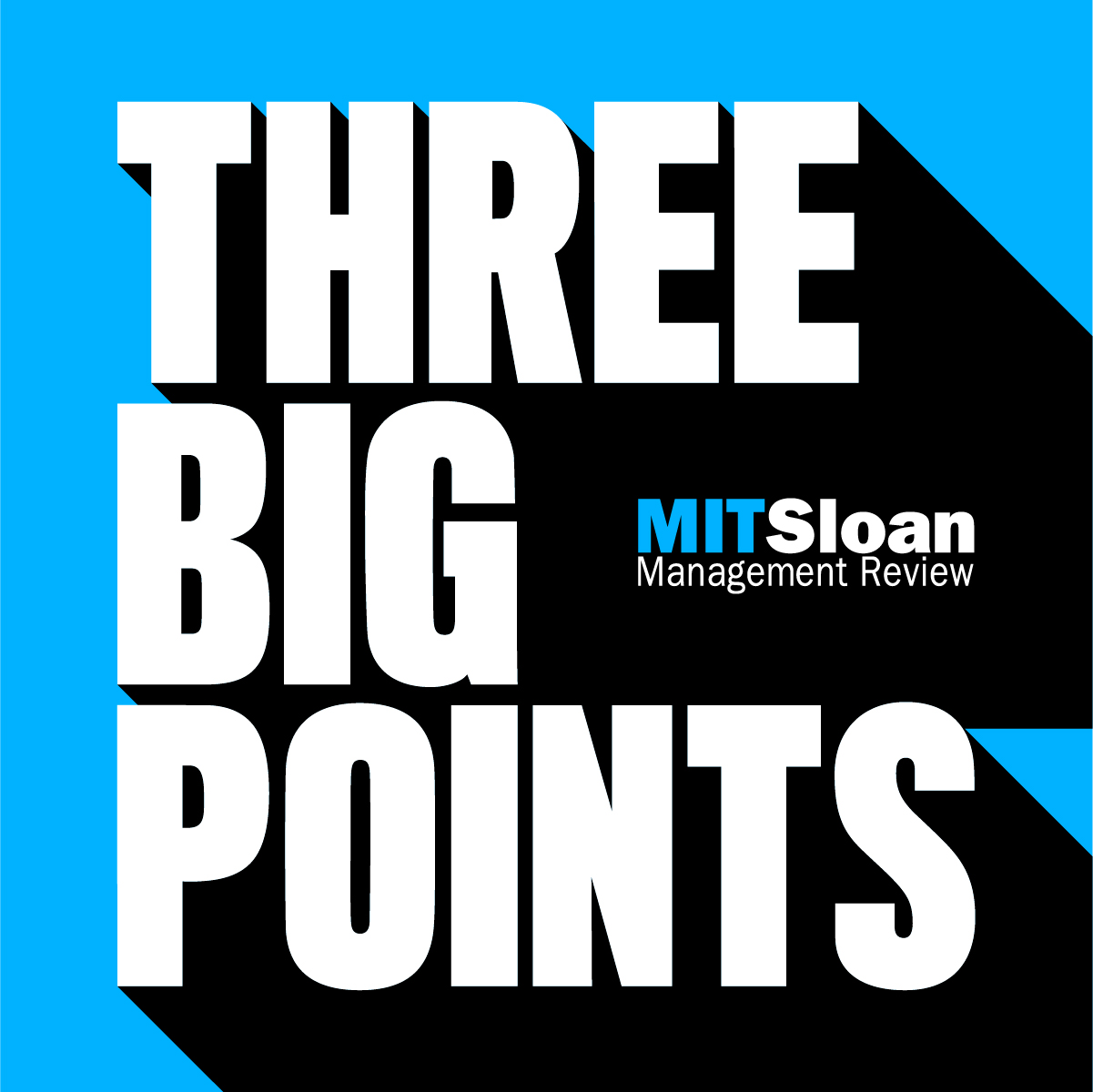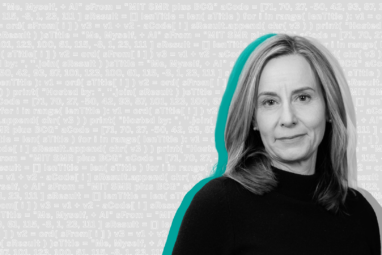This week’s guest has identified 11 — that’s right, 11 — ways in which disruption can sneak up on organizations.
Those 11 sources of macro disruption are — in no particular order — education, infrastructure, government, geopolitics, economy, public health, demographics, environment, telecommunications, wealth distribution, and technology.
That is a lot for companies to monitor. Taken as a list, it’s nearly overwhelming.
So don’t think of it as a list at all, advises Amy Webb, founder of the Future Today Institute and author of the MIT SMR article “The 11 Sources of Disruption Every Company Must Monitor.” Instead, consider these factors as a framework or a guide — a way of intentionally thinking about the world as a business leader — that will help you see where the next potential disruption is coming from, and see it taking shape a mile away rather than when it’s already crashing down upon you.
For some leaders in some organizations, some of the 11 sources may seem disconnected and irrelevant. And though it’s true that certain sources represent more obvious threats depending on a company’s business or industry, the worst mistake you can make is to believe that any are irrelevant.
When you imagine possible disruption coming from all sides, it can make the future seem much more complicated for your company. But doing so allows you to see things — sometimes huge things — you might otherwise miss.
In this week’s episode, Webb explains how to put the framework into action.
For Further Reading
Subscribe to Three Big Points on Apple Podcasts, Spotify, or Google Podcasts via the Subscribe dropdown menu above.
Transcript
Amy Webb: If you are intentionally reading all of the sources of news that you currently read, or listening to podcasts or generally paying attention to your industry, but you’re now doing it intentionally and actively using a framework, you’re going to start noticing things you haven’t before.
What you wind up with is a huge map of information that tells you something about the future of your organization. And from that, you start looking for patterns, and those patterns, at some point, will indicate trends. It’s the building block — the sort of basic “amino acid” of strategic foresight.
Paul Michelman: I’m Paul Michelman, and this is MIT Sloan Management Review’s Three Big Points. Each episode, we take on one topic that leaders need to be on top of right now and leave you with three key takeaways for you and your organization.
And today, we’re bringing you the second in a three-part series honoring the ideas of the late Clayton Christensen, architect of disruptive innovation.
Amy Webb: In this modern age, everything is interconnected, which means that if you’re trying to see the future of one thing — let’s say your field — you really do have to pay attention to developments in adjacent areas to see which connections will catapult change forward into the future. That means you have to pay attention to things like wealth distribution and education. And in both of those cases, we’re talking about who has access to what. Are there groups that are gaining more agency and ability where they live? Are there changes happening to regulations and to permissions?
Paul Michelman: That’s Amy Webb, founder of the Future Today Institute and professor at the Stern School of Business at NYU. Building on the theory that Christensen first put forth more than 25 years ago, disruptive innovation, Webb is among those who have pushed the ideas of disruption forward — and particularly the sources of potential disruption for business.
Webb has identified 11 — that’s right, 11 — ways in which disruption can sneak up on each and every one of us. Those 11 sources of macro disruption are, in no particular order, education, infrastructure, government, geopolitics, economy, public health, demographics, environment, telecommunications, wealth distribution, and technology.
OK. That is a lot for a monitor to monitor. Taken as a list, it’s nearly overwhelming. So, Webb coaches us, don’t think of it as a list at all. Instead, consider these factors as a framework or a guide, a way of intentional thinking about the world as a business leader that will help you see where the next potential disruption is coming from — and to see it taking shape a mile away rather than when it’s already crashing down upon you.
Amy Webb: If you are intentionally reading all of the sources of news that you currently read, or listening to podcasts or generally paying attention to your industry, but you’re now doing it intentionally and actively using a framework, you’re going to start noticing things you haven’t before. So if you’re somebody who’s researching or thinking about or managing cold chains, for example, and suddenly you’re thinking about your industry through the lens of public health or geopolitics or education, and you start thinking about all of the trends and the changes within your industry — [by] including those perspectives, you’re going to start seeing emerging signals and trends that you’ve never seen before; trends that could at some point either provide opportunity for growth or could turn into existential risk.
Paul Michelman: For some leaders in some organizations, some of the 11 sources may seem disconnected or even irrelevant. And while it’s true that certain sources represent more obvious threats, depending on a company’s business or industry, the worst mistake you can make is to believe that any are irrelevant.
Amy Webb: In this modern age, everything is interconnected, which means that if you’re trying to see the future of one thing — let’s say your field — you really do have to pay attention to developments in adjacent areas to see which connections will catapult change forward into the future. That means you have to pay attention to things like wealth distribution and education. And in both of those cases, we’re talking about who has access to what. Are there groups that are gaining more agency and ability where they live? Are there changes happening to regulations and to permissions?
Paul Michelman: Let’s take a concrete example: a little app you may have never heard of called Gollum.
Amy Webb: Essentially, this new app was a way to help people make money while they sleep. Gollum got its idea from something that existed in the ’90s and in fact still exists today. In the ’90s, while you were asleep, you could donate the unused compute power of your computer to others — to researchers and academics who needed supercomputing networks but maybe couldn’t afford to get access to one. So instead, there were these distributed networks of computers all around the world where people had donated their unused compute time while they were asleep, for great projects. Well, fast-forward to now, and that same idea of a distributed computing system still exists. But now you can make money by donating the unused compute in your phone while you’re asleep. And pretty soon, you’re going to be able to donate the unused power in the downtime of all of your appliances, from your connected refrigerators to your washing machines and the like.
Paul Michelman: OK, cool idea. Doesn’t seem broadly threatening, right? Wrong. Webb argues that a little app like Gollum could actually derail a power company. It’s hard to see that line unless you think about disruption the way Webb does.
Amy Webb: Here’s how all of this ties back to the power company. Typically, power companies are looking at things like the number of people who live in an area, the types of devices that they’re using versus the actual usage, and things like weather predictions. What’s not on their radar is a future in which all of the connected devices in our smart homes are running all of the time, constantly pinging networks, making great use of our brand-new 5G technology to earn people money while they sleep. And that could wreak havoc on power companies — everything from the amount of bandwidth that they have to supply to the amount of load that the grid would support. You know, this could be devastating, not just to their ability to provide power to people who need it, but also it could start to ravage their business models.
Paul Michelman: When you think about possible disruption coming from all sides, it can make life much more complicated for your company. But it allows you see things — sometimes huge things — you might otherwise miss.
Amy Webb: China, a couple of years ago, launched something called the belt and road initiative. And it seemed, at that point, like an infrastructure program, where China was going into emerging and developing markets to build new bridges and roads. However … in addition to an infrastructure and trade play, it also turned out to be a way for China to export critical technology and to start building out the frontiers of next-generation networks. So you have to pay attention to what’s happening within government in terms of regulation, in terms of relationships, but also geopolitics. When we think about the future of anything, we’re also paying attention to demographics and public health, because shifts in population and shifts in human migration and where people are living, how long they’re living — all of those key data points impact the future of many different fields.
Paul Michelman: Webb points out that looking at the environment and sustainability is important, not only because a stable environment underpins every company’s ability to do business, but that solutions to help address climate change could emerge from any number of different domains. It’s also important to focus on developments in other key areas, from media to infrastructure.
Amy Webb: But there’s one key area that interconnects all of these sources of disruption and change, and that’s technology. We don’t actually break apart tech as its own source of change, because we really view it as the interconnective tissue binding and connecting all of these other areas of change together.
Paul Michelman: Yup. Trying to see disruption coming feels overwhelming. It seems like it should be enough just to pay attention to the direct competitors out there, to the new apps that might be able to do what you do for cheaper. But thinking broader, Webb says, is the only way to really see the big changes coming.
Amy Webb: The role of the framework is to drastically broaden your perspective when thinking about the future. Most people within organizations think too narrowly. It’s a little bit like taking a pinhole camera, looking out of it, and trying to see very, very clearly everything that’s in front of you. If you don’t intentionally widen the aperture, you’re going to miss what’s coming.
Paul Michelman: That’s Amy Webb. She’s the author of the MIT Sloan Management Review article “The 11 Sources of Disruption Every Company Must Monitor” and the founder of the Future Today Institute.
And that means it’s time for three — not 11 — big points about where to look for disruption where you least expect.
Number one: Use this framework for active reading and listening.
Amy Webb: Anytime that you are doing the normal reading or the research that you would do, have it out next to you and intentionally ask yourself, “Well, if I had to draw a connection between this new development that I’m reading about and my organization and education, what would that make me think of?” The name of the game here is to try to broaden your perspective as much as possible.
Paul Michelman: Number two: Use this framework to broaden the expertise of your teams.
Amy Webb: So when it’s been successful, we’ve seen teams divvy up the 11 macro sources of disruption. And each person, or a smaller group of people, will take on just one of these topics. And essentially, they’ll become the sort of internal experts on infrastructure developments as it relates to the organization. And then, every couple of weeks, that group gets together, and they spend 20 minutes or an hour of just sharing knowledge and information and helping each other see the world, again, as a more complete picture.
Paul Michelman: And number three: Create a network map of signals.
Amy Webb: And this is a pretty easy activity that any organization can do; it just requires a giant whiteboard. So you start with these 11 sources of disruption, and you put each one of them in a circle; treat it as a sort of node. And then from there, you start drawing all of the different inputs — the data points, the signals, anything that you’ve been reading — that seem to be related. And as your team does this, you start adding more nodes, you start adding more signals. What you wind up with is a huge map of information that tells you something about the future of your organization. And from that, you start looking for patterns, and those patterns, at some point, will indicate trends. It’s the building block — the sort of basic “amino acid” of strategic foresight.
Paul Michelman: That’s all for this week’s Three Big Points. Next episode, we’ll conclude this special three-part series with Rita McGrath discussing the next generation of disrupters.
Remember, you can find us on Spotify, Apple Podcasts, Google Podcasts, Stitcher, TuneIn, and wherever fine podcasts are streamed. If you’d like to support our show, please post a rating or a review on whatever podcast platform you prefer.
Three Big Points is produced by Mary Dooe. Music by Matt Reed. Marketing and audience development by Desiree Barry. Our coordinating producers are Michele DeFilippo and Mackenzie Wise.





